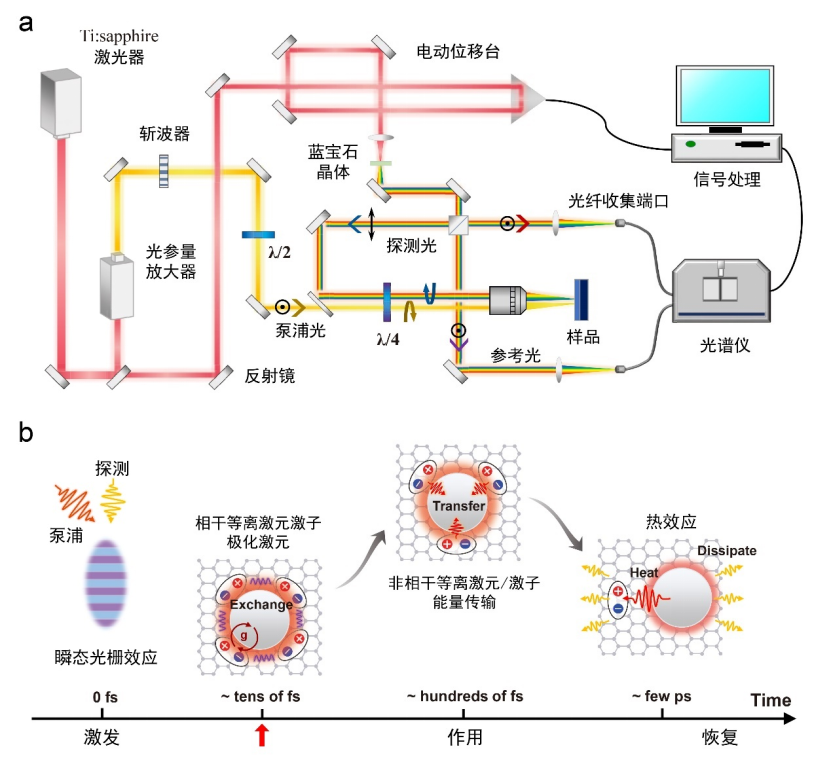
Keywords: Particle Interactions Lock-in Amplifier Microcavity Exciton Polaritons
Note: This article uses the Sine Scientific Instruments OE1022D dual-channel lock-in amplifier for measurements.
[Overview]
In 2022, the research team led by Professor Jiang Tian from the National University of Defense Technology, in collaboration with Professor Shi Lei's team from Fudan University, published an article titled "Interacting Plexcitons for Designed Ultrafast Optical Nonlinearity in a Mono" in RLight: Science & Applications. The article reports on the ultrafast nonlinear optical response of plasmon-exciton polaritons (Plexcitons) at room temperature and experimentally confirms that the exciton dephasing induced by the excitation light is the main physical mechanism underlying the interactions among these special polariton particles.
Microcavity exciton polaritons are coherent quasi-particles formed by the strong coupling between semiconductor excitons and cavity photons. These quasi-particles not only possess the effective light mass and long-range coherence characteristics of photons, but also have strong interaction capabilities among excitons, making it promising to achieve a strong and effective optical nonlinear response.

Fig.1 Ag ND-WS2 Cluster System and Its Steady-State/Utrafast Optical Properties
(a) Schematic diagram of the Ag ND-WS2 hybrid system.
(b) Normalized extinction spectrum of the Ag ND-WS2 hybrid system.
(c) Time-resolved reflection spectrum scan of the zero detuned Ag ND-WS2 system. The inserted white dashed lines indicate the evolution of peak energies for the upper branch (UB) and lower branch (LB) clusters as a function of time.
(d) Reflection spectrum projected from the cross-section of (c) for the Ag ND-WS2 cluster system at t = 100 fs. From bottom to top, the incident flux increases from 0.2 µJ cm-2 to 12.5 µJ cm-2. The gray dashed line represents the probe reflection spectrum at -1 ps, unaffected by the pump pulse.
[Sample & Test]
Ultrafast Dynamics
The self-constructed ultrafast time-resolved microscopic spectroscopy technique (see Figure 2(a)) has conducted an in-depth exploration of the ultrafast dynamics of the Plexitons system under complete resonant pumping excitation conditions, successfully revealing the physical processes of optical responses of Plexitons at different time scales, as shown in Figure 2(b). These processes mainly include: (I) ultrafast relaxation of coherent plasmon-exciton polaritons, (II) energy transfer of incoherent plasmon/excitons (~0.6 ps), and finally (III) thermal effects due to plasmon heating of the lattice (~5 ps). This dynamical result indicates that the lifetime of coherent Plexitons is extremely short; therefore, only the experimental spectra detected within the first 100 fs can reflect the intrinsic optical response of Plexitons.

Fig.2 Ultrafast Dynamics Study of the Ag ND-WS2 Plexciton System.
(a) Schematic diagram of the ultrafast microscopic spectroscopy device with complete resonant pumping and detection capabilities.
(b) The physical mechanisms of optical responses in the Ag ND-WS2 Plexciton system at different time scales.
Particle Interactions
Based on the above dynamical results, the research team analyzed the intrinsic nonlinear optical response of Plexitons. Through spectral theoretical analysis and experimental validation of a coupled resonator model, the team found that the interactions among Plexitons particles primarily occur through their exciton components. The physical mechanisms of particle interactions are mainly of three types (see Figure 3): (I) exchange repulsion, (II) state filling saturation, and (III) dephasing interactions. Among these, dephasing is the predominant form of interaction between particles. This is due to the sub-wavelength scale optical space compression capability of the metal nanocavity, which brings the polariton particles closer together, enhancing collision interactions that ultimately manifest as higher-order interactions. Compared to the interactions among excitons in WS₂, the team found that the interaction strength among Plexitons particles is nearly ten times stronger, further indicating that the Plexitons system exhibits considerable particle interaction strength.

Fig.3 Three Physical Mechanisms of Particle Interactions in the Ag ND-WS2 Plexciton System.
Optical Nonlinear Control
Thanks to the strong interactions among Plexitons particles and the convenient tunability of the Ag ND-WS₂ heterostructure, the research team employed a Si detector and a dual-channel lock-in amplifier (Sine Scientific Instrument, OE1022D) to measure the transmitted light intensity and incident light intensity, achieving controllable design of the system’s optical nonlinear absorption characteristics in this solid-state structure, as shown in Figure 4. By varying the coupling strength, the team was able to modulate the intensity of the nonlinear absorption curve (see Figures 4(a,b)); by changing the resonance position, they achieved a switch between the anti-saturation absorption signal and the saturation absorption signal (see Figures 4(c,d)). This strong and controllable optical nonlinearity makes Plexitons an ideal platform for studying room-temperature optical nonlinear devices, further promoting the development of polariton photonics and applications.

Fig. 4 Control of Linear and Nonlinear Optical Responses in Ag ND-WS2 Plexciton Devices.
(a-b) Steady-state reflection spectrum (a) and nonlinear absorption characteristics (b) controlled by the thickness of the spatial insulating layer.
(c-d) Steady-state reflection spectrum (c) and nonlinear absorption characteristics (d) controlled by the size of the nanodisks.
[Summary]
By systematically studying the nonlinear optical response of Plexcitons, the research team experimentally confirmed that Plexcitons not only remain stable at room temperature but also exhibit strong particle interactions. They successfully achieved effective control over the optical nonlinear absorption characteristics in this system. This result provides new insights for the development of optical nonlinear devices and is expected to promote the advancement of optical switches in all-optical logic devices and nonlinear activation function devices in all-optical neural networks.
[Literature]
[Recommended Products]

















